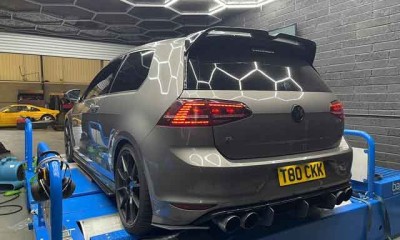Stage 2 Tune: What It Is & Stage 3 Explained for Performance Enthusiasts

Hey, we are HP Chiptuningfiles – Europe’s leading ECU tuning file service provider. We deliver custom, dyno-tested tuning files for diesel, petrol & hybrid engines, trusted by 4,000+ clients worldwide. If you're looking to unlock your vehicle's potential through professional chiptuning files, you've come to the right place. In this comprehensive guide, we'll dive deep into stage 2 tunes, explain what stage 3 entails, and help you decide which might be right for your car.
What Is ECU Tuning and Why Does It Matter?
ECU tuning, also known as chip tuning or remapping, involves modifying the software in your vehicle's Engine Control Unit (ECU) to optimize performance parameters like fuel injection, ignition timing, and turbo boost pressure. This process can significantly increase horsepower, torque, and efficiency without necessarily altering hardware. At its core, ECU tuning adjusts the engine's operating maps to extract more power from the existing setup.
In 2025, with advancements in automotive technology, ECU tuning has become more sophisticated. Modern vehicles with turbocharged engines, such as those from BMW or Mercedes-Benz, respond exceptionally well to these modifications. For instance, our hp chiptuning services ensure safe, reliable gains tailored to your specific model.
But why tune your ECU? Benefits include improved throttle response, better fuel economy in some cases, and enhanced driving dynamics. However, it's crucial to use trusted providers to avoid engine damage. Explore our tuning file database to see compatible options for your vehicle.
If you're new to this, check out our related article on ECU Programming vs Reprogramming Guide 2024 for foundational knowledge.
Understanding Tuning Stages: From Basics to Advanced
Tuning stages categorize the level of modifications applied to a vehicle, starting from simple software tweaks to extensive hardware overhauls. These stages help enthusiasts and professionals communicate the extent of upgrades clearly. While definitions can vary slightly by tuner or manufacturer, the general framework remains consistent across the industry.
Stage 1 Tuning: The Entry Point
Stage 1 is the most basic level, focusing solely on ECU software remapping without any hardware changes. This stage optimizes the factory settings for better performance, often yielding 10-20% gains in power and torque. It's ideal for daily drivers seeking subtle improvements.
Pros:
-
Reversible and often undetectable by dealers
-
Cost-effective
-
Maintains reliability
Cons:
-
Limited by stock hardware
-
Minimal gains compared to higher stages
For more on this, read our Stage 1 2 3 ECU Tuning Guide.
Stage 2 Tuning: Balancing Performance and Practicality
A stage 2 tune builds upon stage 1 by incorporating select hardware upgrades alongside an adjusted ECU map. Typically, this includes modifications to the intake system, exhaust (such as a high-flow downpipe or cat-back system), and sometimes an upgraded intercooler. These changes improve airflow and reduce restrictions, allowing the engine to breathe better and produce more power—often 20-40% over stock.
What does a stage 2 tune involve exactly?
-
Intake Upgrades: Cold air intakes or high-flow filters to increase air volume.
-
Exhaust Modifications: Downpipes and exhaust systems to expel gases more efficiently.
-
ECU Remap: Custom software to match the new hardware, adjusting boost, fuel, and timing.
-
Optional Add-ons: Boost controllers or upgraded diverter valves for turbocharged engines.
For example, on a Volkswagen Golf GTI, a stage 2 tune might add 50-80 horsepower, transforming it into a more spirited performer. At HP Chiptuningfiles, our chiptuning file service provides dyno-tested stage 2 files that ensure safety and optimal results. Interested? Create an account today to get started.
Pros of Stage 2:
-
Significant power gains without extreme costs
-
Improved throttle response and sound
-
Still suitable for street use
Cons:
-
May void warranties
-
Requires professional installation
-
Potential for increased emissions
Learn more about compatible hardware in our Hardware section.
Stage 3 Tuning: Pushing the Limits
What does stage 3 mean in cars? Stage 3 represents the pinnacle of tuning for most enthusiasts, involving major hardware overhauls like larger turbochargers, upgraded fuel systems (injectors and pumps), and even internal engine components such as forged pistons or cams. This stage is designed for maximum power, often doubling stock output, but it demands a comprehensive ECU tune to integrate everything safely.
Key elements of a stage 3 tune:
-
Forced Induction Upgrades: Bigger turbos or superchargers for higher boost levels.
-
Fuel System Enhancements: High-flow injectors and pumps to handle increased demands.
-
Engine Internals: Reinforced parts to withstand stress.
-
Cooling Improvements: Larger radiators or oil coolers.
-
Advanced ECU Mapping: Custom files to optimize all parameters.
For high-performance models like the BMW M5, stage 3 can unlock over 700 horsepower, but it's not for the faint-hearted. Our hp tuning files are perfect for stage 3 setups, offering precision-tuned solutions. Visit our Chiptuning Files page to explore options.
Pros:
-
Extreme power and torque gains
-
Track-ready performance
-
Customizable for specific goals
Cons:
-
High cost (thousands of euros)
-
Reduced reliability and lifespan
-
Often not road-legal; increased maintenance
For insights on specific models, see our BMW M5 ECU Tuning with FEMTO Unlock.
Stage 2 vs Stage 3: Key Differences and Comparison
While both stages enhance performance beyond stock, the differences lie in scope, cost, and risk. Stage 2 is more accessible, focusing on bolt-on mods, whereas stage 3 delves into invasive changes.
Here's a comparison table:
|
Aspect |
Stage 2 Tune |
Stage 3 Tune |
|
Hardware Changes |
Intake, exhaust, intercooler |
Turbo upgrade, fuel system, internals |
|
Power Gains |
20-40% over stock |
50-100%+ over stock |
|
Cost |
€500-€2000 |
€3000-€10000+ |
|
Reliability |
High, with proper tuning |
Lower, requires monitoring |
|
Suitability |
Daily driving, enthusiasts |
Track, high-performance builds |
|
Installation Time |
1-2 days |
Several days to weeks |
This table highlights why many choose stage 2 for a balanced upgrade. For more on tuning methods, read our OBD vs Bench vs BDM Tuning.
Pros and Cons of Stage 2 and Stage 3 Tunes
Stage 2 Pros and Cons
Pros:
-
Affordable entry to serious performance
-
Enhances driving experience without overkill
-
Compatible with most vehicles via our tuning file service
Cons:
-
May require emissions testing adjustments
-
Potential for minor drivability issues if not tuned well
Stage 3 Pros and Cons
Pros:
-
Unmatched acceleration and top speed
-
Fully customizable for racing or show
Cons:
-
Expensive maintenance
-
Risk of engine failure if not done right
-
Legal implications in some regions
To mitigate risks, always use dyno-tested files from experts like us. Check our Dyno-Tested ECU Tuning Files.
How to Choose Between Stage 2 and Stage 3
Choosing depends on your goals, budget, and vehicle use. For street cars, stage 2 offers great value. If you're chasing track times, stage 3 is worth it—but prepare for the commitment.
Factors to consider:
-
Vehicle type: Diesels like Ford Transit respond well to stage 2; see our Ford Transit ECU SID212 SID212EVO Tuning.
-
Budget: Start with stage 2 and upgrade later.
-
Expertise: Use professional services to avoid pitfalls.
Ready to tune? Buy credits now for instant access to our files.
For outbound resources, learn more about general ECU basics from Wikipedia's ECU Page or explore tuning kits at APR Tuning. Another great source is Cobb Tuning's Stage Guide.
Why Choose HP Chiptuningfiles for Your Stage 2 or Stage 3 Tune?
As leaders in hp-chiptuningfiles, we specialize in custom files for all stages. Our dyno-tested approach ensures safety and performance, whether for petrol, diesel, or hybrids. With over 4,000 clients, we're committed to innovation—check our News for updates like Why Custom ECU Tuning Files Matter in 2025.
Contact us for personalized advice, or visit About Us to learn more.
FAQ
What is a stage 2 tune?
A stage 2 tune combines ECU remapping with hardware upgrades like intake and exhaust for moderate performance gains.
What does stage 3 mean in cars?
Stage 3 means extensive modifications including turbo upgrades and internals for maximum power, often for track use.
How much HP does a stage 2 tune add?
It varies by vehicle, but typically 50-100 HP on turbocharged engines. For specifics, see our How Much HP Does a Tune Add.
Is stage 3 tuning safe for daily driving?
It's possible but not recommended due to reliability concerns; stage 2 is better for everyday use.
Ready to elevate your ride? Create an account or buy credits today with HP Chiptuningfiles, your trusted chip tuning files provider.
Other news and updates

Read more OBD Breakthrough: Tuning Support for the Continental ASG1 ECU in Audi e-tron & Porsche Taycan
The Continental ASG1 ECU used in the Audi e-tron and Porsche Taycan is now fully supported for OBD read/write. This breakthrough allows safe tuning of torque limits, current maps, thermal strategies and pedal response, enabling measurable performance gains whi...
Read more

Read more Stage 1, Stage 2, and Stage 3 Tuning: Which One Is Right for You? | HP Chiptuning Files Europe & UK
Discover the differences between Stage 1, Stage 2, and Stage 3 tuning. Learn which remap is best for your car, driving style, and budget at hp-chiptuningfiles.com.
Read more

Read more Mercedes-AMG G63 2025: ECU Remap & Performance Boost
Hey, we are HP Chiptuningfiles – Europe’s leading ECU tuning file service provider. We deliver custom, dyno-tested tuning files for diesel, petrol & hybrid engines, trusted by 4,000+ clients worldwide. The 2025 Mercedes-AMG G63 combines iconic G-Class ruggedne...
Read more